Estimation of Ocean Thermal Energy Conversion Resources in the East of Malaysia
Abstract
1. Introduction
2. Methodology
2.1. Sites of Investigation
2.2. Method of Investigation
3. Results and Discussion
3.1. Temperature Profile
3.2. Salinity Profile
3.3. Dissolved Oxygen Profile
3.4. Water Mass (T-S Profile)
3.5. Approximation of OTEC Potential Power Production Capacity
4. Conclusions
- (1)
- With regards to seawater temperature, the Japan Oceanographic Data Center (JODC) of Semporna, Tawau, Kudat, Pulau Layang-Layang and Pulau Kalumpang of Sabah showed no remarkable difference between the sites. On average, the surface seawater temperature was 27 °C. Deep seawater temperature at 600 m depth was approximately 7.0 °C.
- (2)
- Seawater salinity in waters shallower than 600 m had greater variability than that in waters deeper than 600 m, between 33.5 and 34.7 PSU.
- (3)
- The dissolved oxygen profile at Pulau Kalumpang showed a similarity to the case of seawater temperature and salinity. In the area shallower than 300 m, it had greater variability than at further depths.
- (4)
- The T-S profile in water deeper than 200 m showed the same pattern, while at shallower depths, different characteristics of the water mass were described. In waters shallower than 200 m, the arc of the pattern became fairly large, while in water deeper than 200 m, it showed about the same tendency as those recorded in the northern part of South China Sea territories, such as Palau, Okinawa and Kumejima.
- (5)
- The renewable energy to be generated by an OTEC system within the Malaysian EEZ, based on two calculation methods—one using the heat quantity of the temperature difference of seawaters and the other using the heat flux of solar energy—should be an amount similar to and four times greater than, respectively, the current government target for RE power generation by 2025.
Author Contributions
Funding
Acknowledgments
Conflicts of Interest
Abbreviations
| RE | Renewable Energy |
| OTEC | Ocean Thermal Energy Conversion |
| PV | Photovoltaics |
| MW | Megawatt |
| JODC | Japan Oceanographic Data Center |
| EEZ | Exclusive Economic Zone |
| °C | Degrees Celsius |
| M | Meter |
| Approx. | Approximately |
| PSU | Practical Salinity Unit |
| mL/L | Milliliters per liter |
| T-S | Temperature-Salinity |
| cm | Centimeter |
| km | Kilometer |
| kWh | Kilowatt-hour |
| LNG | Liquid Natural Gas |
| SDGs | Sustainable Development Goals |
| DO | Dissolved Oxygen |
| CTD | Conductivity, Temperature and Depth |
| KCl | Potassium Chloride |
| mmho | Milli-mho |
| db | Decibel |
References
- Hock, S.S. The Population of Peninsular Malaysia; Institute of Southeast Asian Studies: Singapore, 2007; ISBN 978-981-230-427-8. [Google Scholar]
- The Land (West Malaysia). Encyclopedia Britannica. 2020. Available online: https://www.britannica.com/place/Malaysia/Plant-and-animal-life. (accessed on 30 April 2020).
- Department of Statistics Malaysia. 2016. Available online: https://www.dosm.gov.my. (accessed on 30 July 2008).
- Malaysia Maritime Claims 2019—Geography. Available online: http://www.indexmundi.com/ (accessed on 29 January 2020).
- ASEAN Centre for Energy. 2019. Available online: https://aeds.aseanenergy.org/country/malaysia/ (accessed on 25 April 2020).
- Nakaoka, T.; Nishida, T.; Ichinose, J.; Nagatomo, K.; Mizatani, S.; Tatsumi, S.; Matsushita, M.; Pickering, T.; Ikegami, Y.; Uehara, H. Oceanographic observations and an estimate of the renewable energy for ocean thermal energy conversion in the coast of the Fiji Island. Deep Ocean Water Res. 2003, 4, 57–66. [Google Scholar]
- Uehara, H.; Dilao, C.O.; Nakaoka, T. Conceptual Design of Ocean Thermal Energy Conversion (OTEC) Power Plants in the Philippines. J. Sol. Energy 1988, 41, 431–441. [Google Scholar] [CrossRef]
- Wolff, A.W.; Hubert, E.W.; Wolff, M.P. OTEC World Thermal Resource. In Proceedings of the Ocean Conference, Washington, DC, USA, June 19–22 1979; pp. 13.5.1–13.5.7. [Google Scholar]
- Rajagopalan, K.; Nihous, G.C. Estimates of Ocean Thermal Energy Conversion (OTEC) resources using an ocean general circulation model. Renew. Energy 2013, 50, 532–540. [Google Scholar] [CrossRef]
- Nihous, G.C. An estimation of Atlantic Ocean thermal energy conversion (OTEC) resources. Ocean Eng. 2007, 34, 2210–2221. [Google Scholar] [CrossRef]
- Hammar, L.; Ehnberg, J.; Mavume, A.; Cuamba, B.C.; Molander, S. Renewable ocean energy in the Western Indian Ocean. Renew. Sust. Energ. Rev. 2012, 16, 4938–4950. [Google Scholar] [CrossRef]
- Liu, T.; Hirose, N.; Yamada, H.; Ikegami, Y. Estimation of ocean thermal energy potential in the Aguni Basin. Appl. Ocean Res. 2020, 101, 102185. [Google Scholar] [CrossRef]
- VanZwieten, J.H.; Rauchenstein, L.T.; Lee, L. An assessment of Florida’s ocean thermal energy conversion. Renew. Sust. Energ. Rev. 2017, 75, 683–691. [Google Scholar] [CrossRef]
- Zahraee, S.M.; Golroudbary, S.R.; Shiwakoti, N.; Kraslawski, A.; Stasinopoulos, P. An investigation of the environmental sustainability of palm biomass supply chains via dynamic simulation modeling: A case of Malaysia. J. Clean. Prod. 2019, 237, 117740. [Google Scholar] [CrossRef]
- Benjamin, M.; Okamura, S.; Nakamura, Y.; Yasunaga, T.; Ikegami, Y. Status of the “Kumejima Model” for advanced deep seawater utilization. In Proceedings of the 2016 Techno-Ocean, Kobe, Japan, 6–8 October 2016. [Google Scholar]
- Takahashi, M.M. Ocean fertilization using deep ocean water (DOW). Deep Ocean Water Res. 2003, 4, 73–87. [Google Scholar]
- Hernandez-Romero, I.M.; Fuentes-Cortes, L.F.; Mukherjee, R.; El-Halwagi, M.M.; Serna-Gonzalez, M.; Napoles-Rivera, F. Multi-scenario model for optimal design of seawater air-conditioning systems under demand uncertainty. J. Clean. Prod. 2019, 238, 117863. [Google Scholar] [CrossRef]
- Yoshizuka, K.; Holba, M.; Yasunaga, T.; Ikegami, Y. Performance evaluation of benchmark plant for selective lithium recovery from seawater. J. Ion Exch. 2007, 18, 450–453. [Google Scholar] [CrossRef]
- Avery, W.; Wu, C. Renewable Energy from The Ocean—A Guide to OTEC; Oxford University Press, Inc.: New York, NY, USA, 1994; ISBN 0195071999. [Google Scholar]
- Yasunaga, T.; Ikegami, Y. Finite-time thermodynamic model for evaluating heat engines in ocean thermal energy conversion. Entropy 2020, 22, 211. [Google Scholar] [CrossRef] [PubMed]
- Ikegami, Y.; Yasunaga, T.; Morisaki, T. Ocean thermal energy conversion using double-stage Rankine cycle. J. Sci. Mar. Eng. 2018, 6, 21. [Google Scholar] [CrossRef]
- Uehara, H.; Miyara, A.; Nakaoga, T.; Nishida, T. A Study on an Ocean Thermal Energy Conversion Plant Using Integrated Hybrid cycle in the Oki-no-Erabu Island. In Proceedings of the Second International Offshore and Polar Engineering Conference, San Francisco, CA, USA, 14–19 June 1992; pp. 599–606. [Google Scholar]
- Japan Oceanographic Data Center. 2020. Available online: https://www.jodc.go.jp/jodcweb/ (accessed on 20 April 2020).
- Quek, T.Y.A.; Alvin Ee, W.L.; Chen, W.; Ng, T.S.A. Environmental impacts of transitioning to renewable electricity for Singapore and the surrounding region: A life cycle assessment. J. Clean. Prod. 2019, 214, 1–11. [Google Scholar] [CrossRef]
- Magesh, R. OTEC Technology—A World of Clean Energy and Water. In Proceedings of the World Congress on Engineering; Ao, S.I., Gelman, L., Hukins, D.W.L., Korsunsky, A.M., Eds.; WCE: London, UK, 2010; ISBN 978-988-18210-7-2. [Google Scholar]
- Yoza, B.A.; Nihous, G.C.; Takahashi, P.K.; Golmen, L.G.; War, J.C.; Otsuka, K.; Masutani, S.M. Deep ocean water resources in the 21st century. Mar. Technol. Soc. J. 2010, 44, 80–87. [Google Scholar] [CrossRef]
- Ikegami, Y.; Urata, K.; Fukumiya, K.; Noda, N.; Decherong, G. Oceanographic Observation in the Palau waters for utilization of cold deep seawater. In Proceedings of the 6th Conference at Kumejima session of Japan Association of Deep Ocean Water Applications, Seoul, Korea, 19–24 June 2002. [Google Scholar]
- Takano, K. Volume of Energy of Deep Seawater. Japan Assoc. Deep Ocean Water Appl. News 2002, 6, 8–10. (In Japanese) [Google Scholar]
- Direct Energy Conversion. Energy Resources Engineering; OHM: Tokyo, Japan, 1991; pp. 178–181. (In Japanese) [Google Scholar]
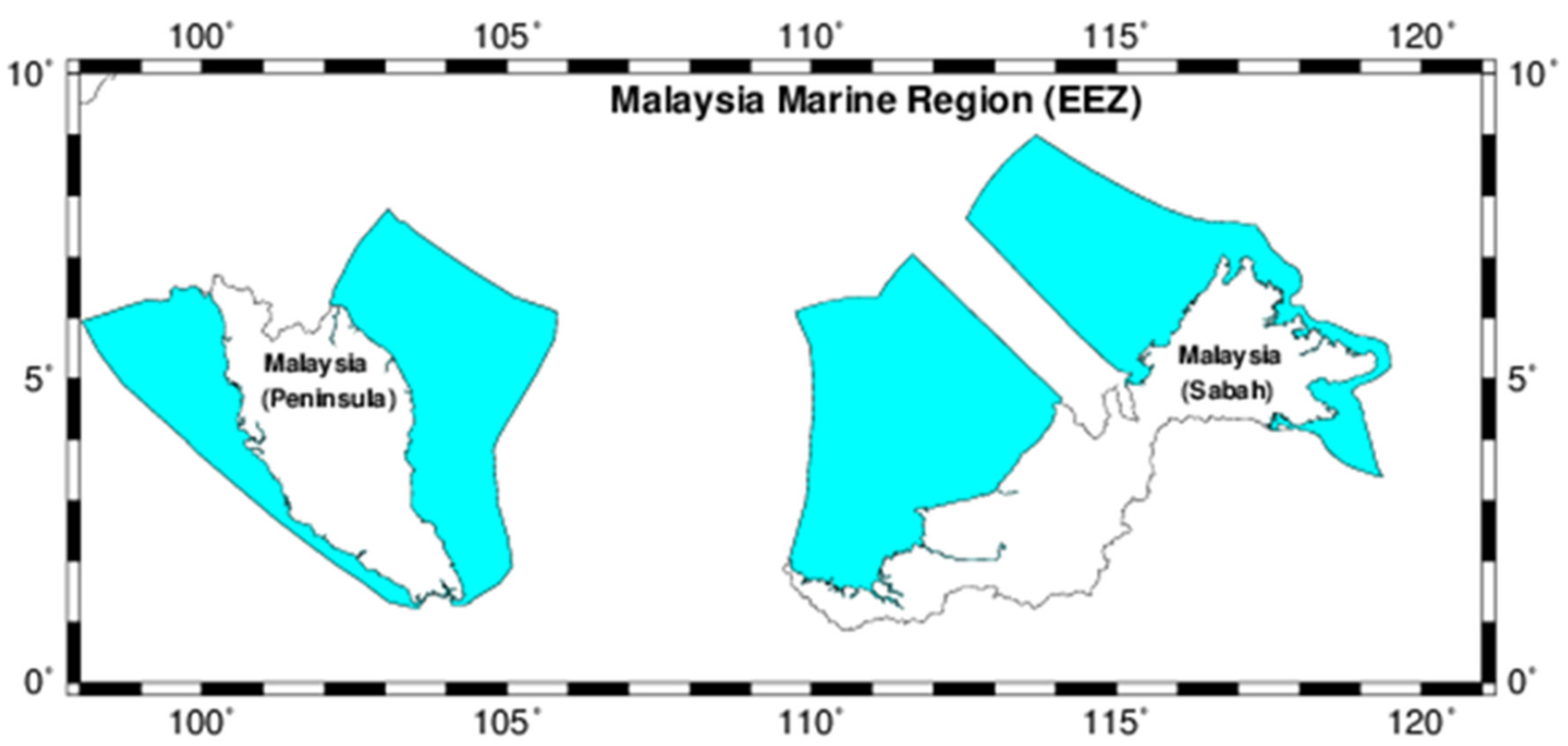
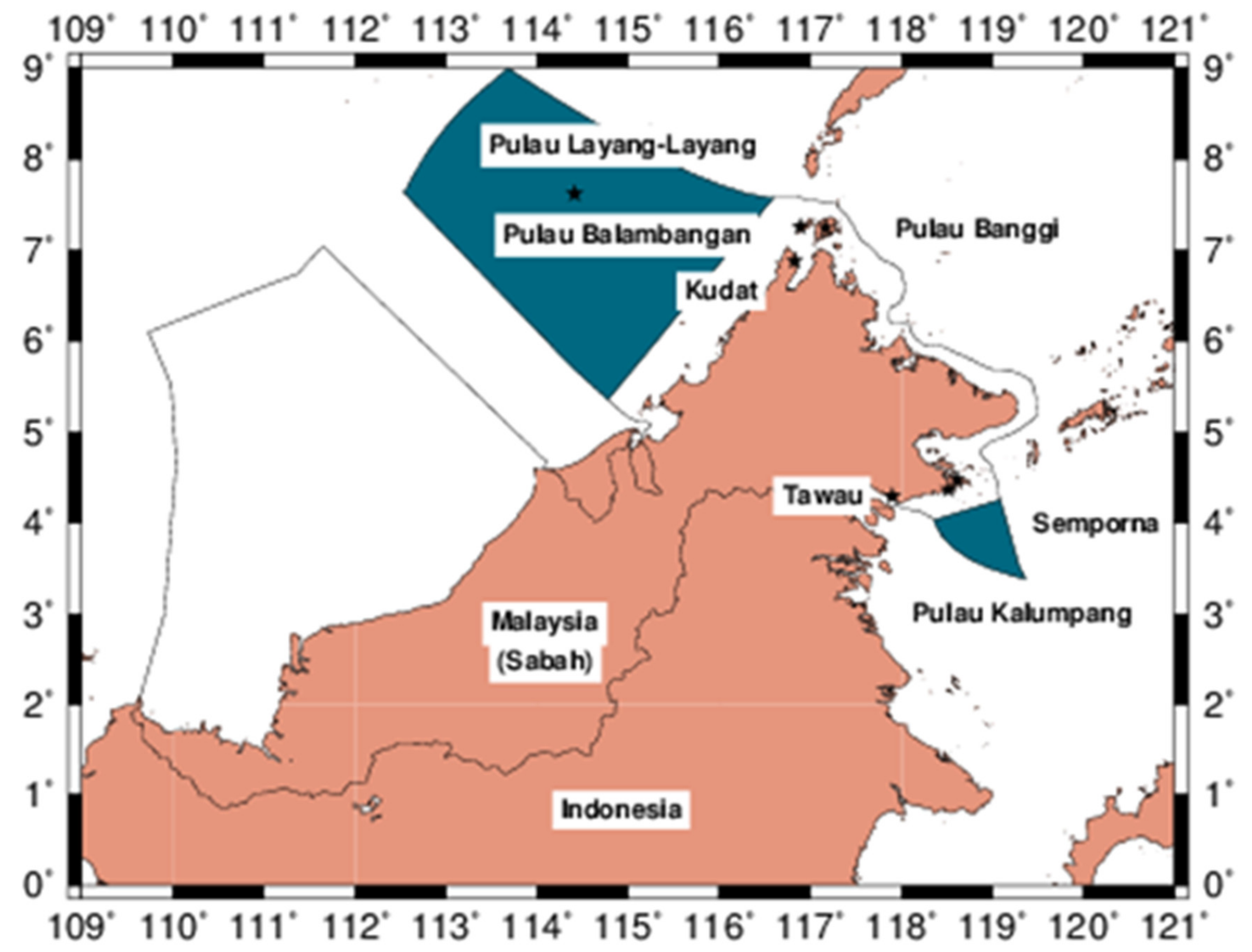
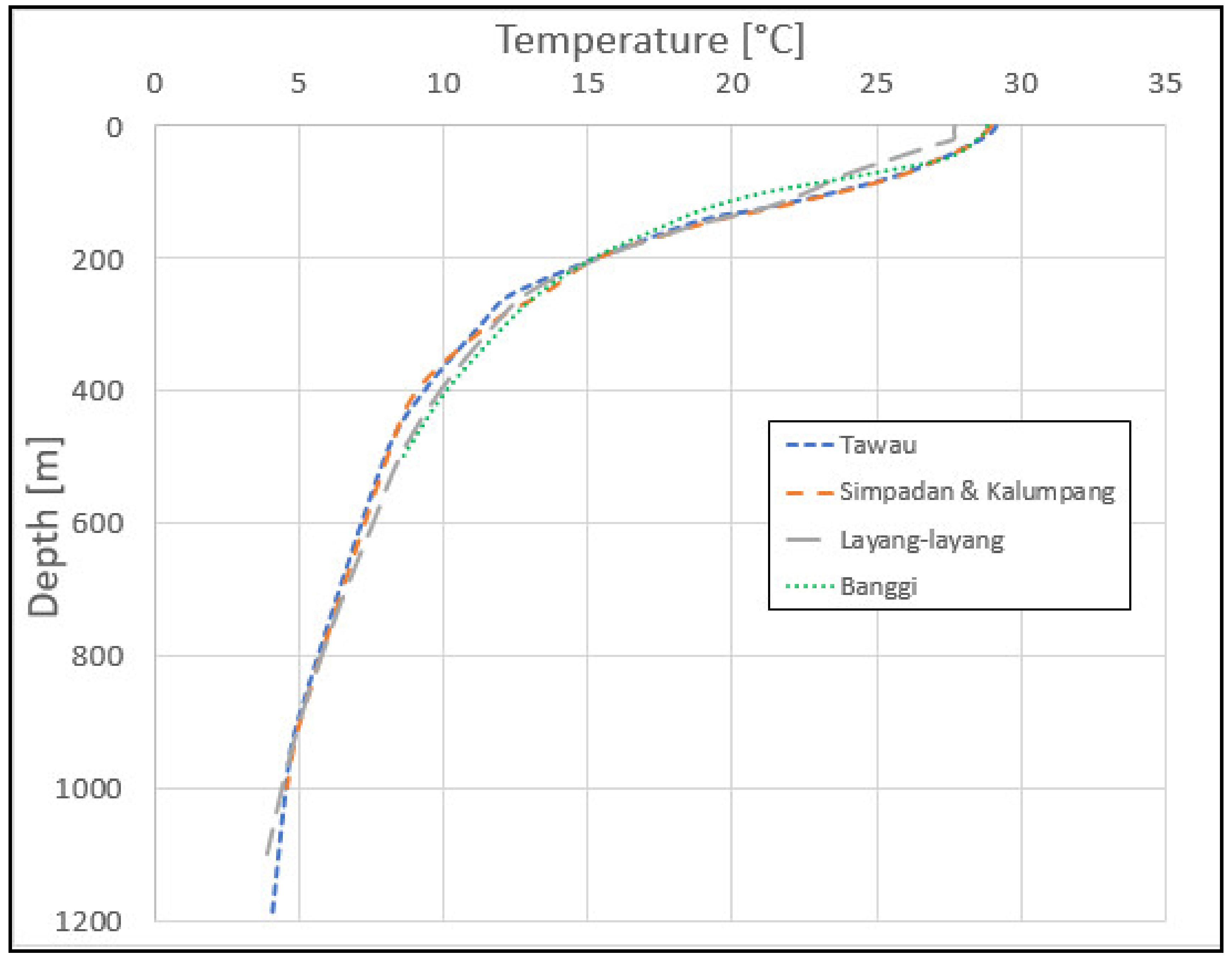
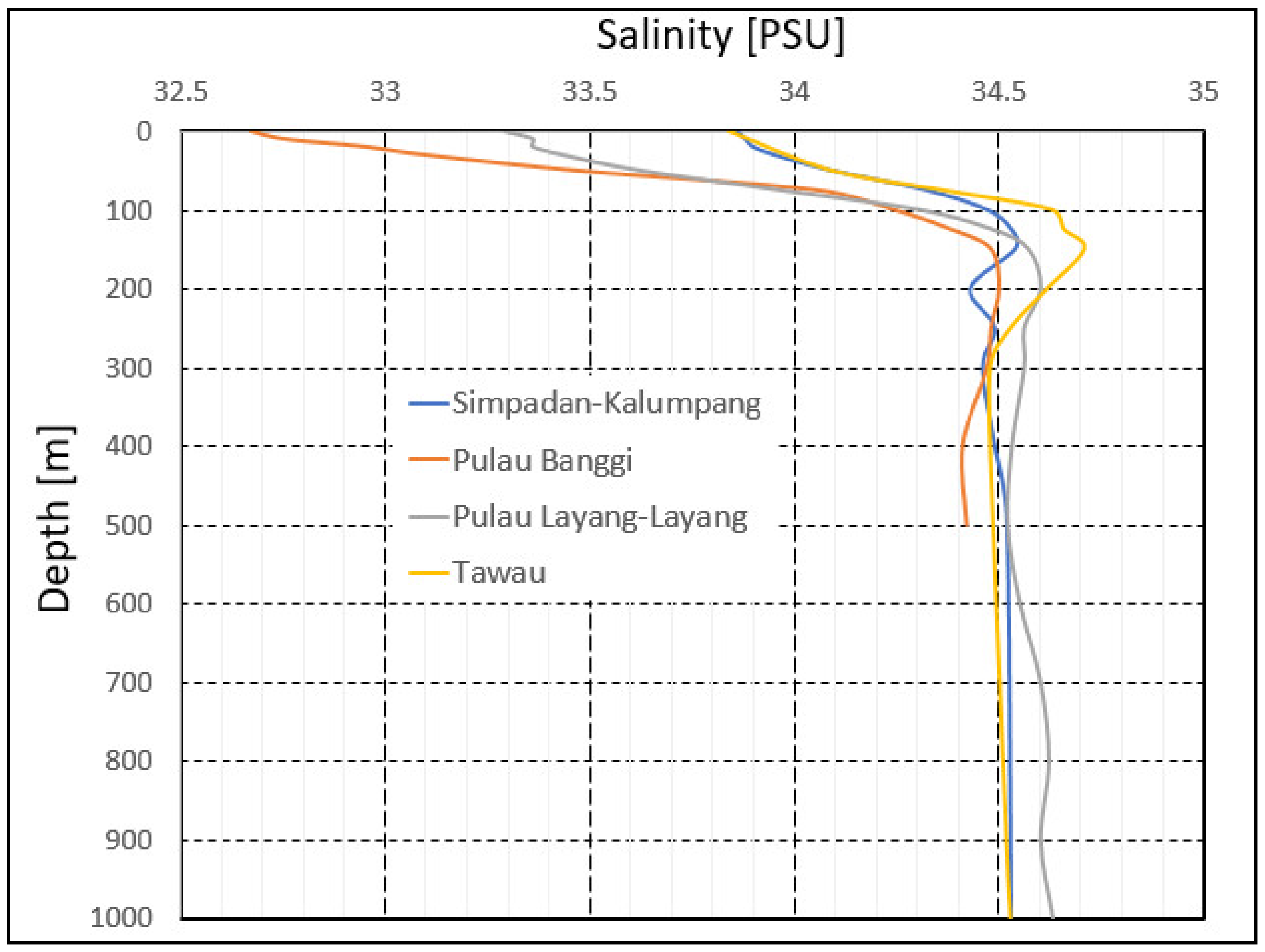
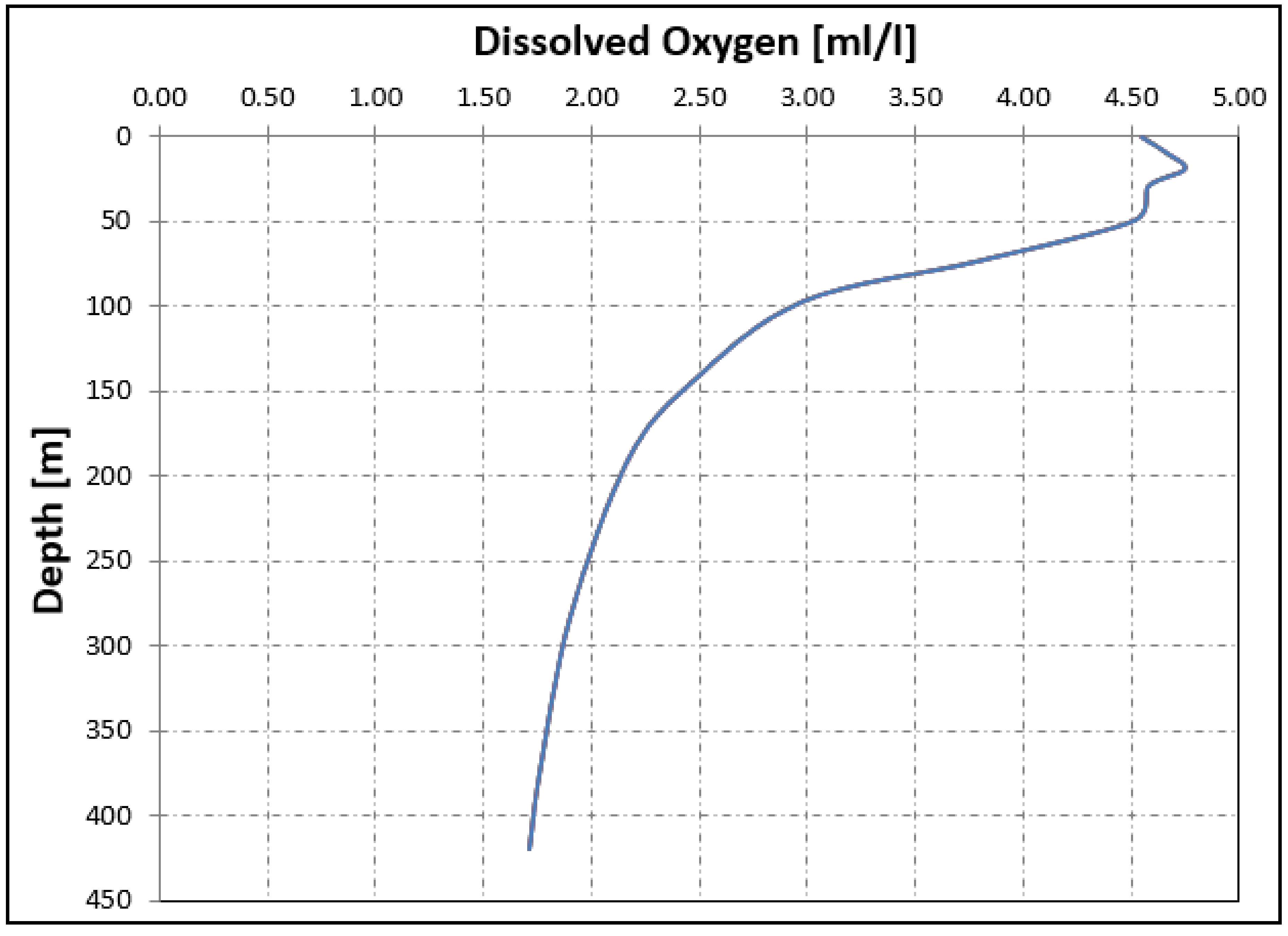
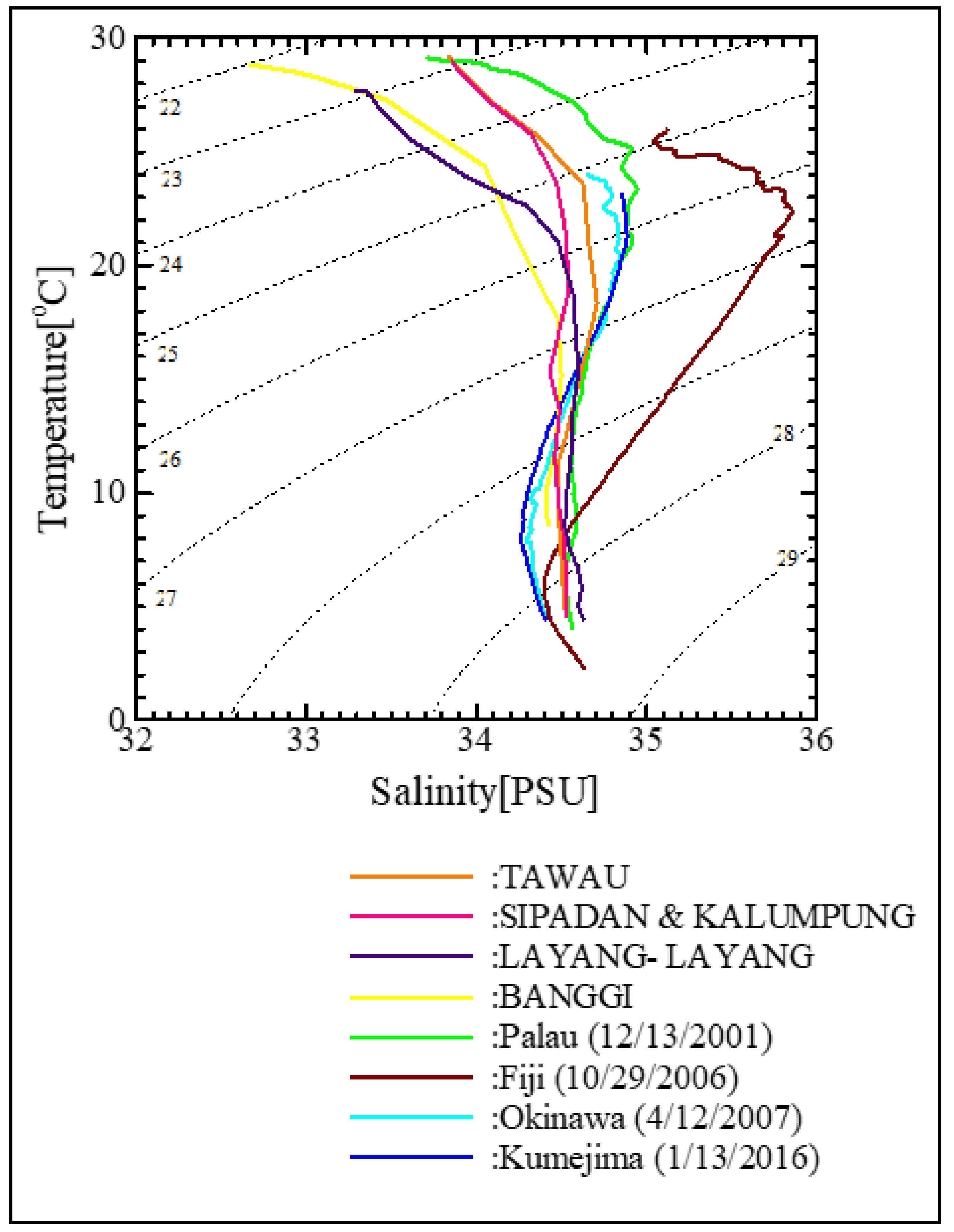
| Parameter | Range | Accuracy |
|---|---|---|
| Conductivity | 1–65 mmho | ±0.005 mmho |
| Temperature | −32–+32 °C | ±0.005 °C |
| Pressure | 0–320 db | ±0.5 db |
| 0–650 db | ±1.0 db | |
| 0–1600 db | ±1.6 db | |
| 0–3200 db | ±3.2 db | |
| 0–6500 db | ±6.5 db |
Publisher’s Note: MDPI stays neutral with regard to jurisdictional claims in published maps and institutional affiliations. |
© 2020 by the authors. Licensee MDPI, Basel, Switzerland. This article is an open access article distributed under the terms and conditions of the Creative Commons Attribution (CC BY) license (http://creativecommons.org/licenses/by/4.0/).
Share and Cite
T. Thirugnana, S.; Jaafar, A.B.; Yasunaga, T.; Nakaoka, T.; Ikegami, Y.; Su, S. Estimation of Ocean Thermal Energy Conversion Resources in the East of Malaysia. J. Mar. Sci. Eng. 2021, 9, 22. https://doi.org/10.3390/jmse9010022
T. Thirugnana S, Jaafar AB, Yasunaga T, Nakaoka T, Ikegami Y, Su S. Estimation of Ocean Thermal Energy Conversion Resources in the East of Malaysia. Journal of Marine Science and Engineering. 2021; 9(1):22. https://doi.org/10.3390/jmse9010022
Chicago/Turabian StyleT. Thirugnana, Sathiabama, Abu Bakar Jaafar, Takeshi Yasunaga, Tsutomu Nakaoka, Yasuyuki Ikegami, and Suriyanti Su. 2021. "Estimation of Ocean Thermal Energy Conversion Resources in the East of Malaysia" Journal of Marine Science and Engineering 9, no. 1: 22. https://doi.org/10.3390/jmse9010022
APA StyleT. Thirugnana, S., Jaafar, A. B., Yasunaga, T., Nakaoka, T., Ikegami, Y., & Su, S. (2021). Estimation of Ocean Thermal Energy Conversion Resources in the East of Malaysia. Journal of Marine Science and Engineering, 9(1), 22. https://doi.org/10.3390/jmse9010022






